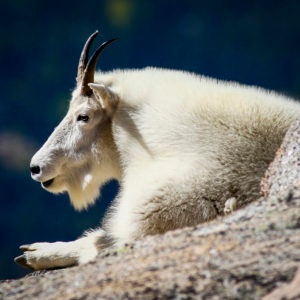 If you’ve ever spent time in the mountainous regions of North America, you may have seen large white animals with curved horns and long scraggly beards scaling the rock faces of steep cliffs. These unique mountain-climbing creatures are highly specialized animals known as mountain goats.
If you’ve ever spent time in the mountainous regions of North America, you may have seen large white animals with curved horns and long scraggly beards scaling the rock faces of steep cliffs. These unique mountain-climbing creatures are highly specialized animals known as mountain goats.
Mountain goats are extremely well equipped to living at high elevations. Many animals might have a difficult time maneuvering around the steep and rocky terrain of the alpine regions of mountains, but not mountain goats! They are known for their agility and can easily climb even the steepest cliffs. Mountain goats are such adept climbers because have two-toed hooves that are fortified with tough, rubber-like pads. The padding on their hooves provides them with the grip they need to cling to rocks and steep slopes. These hooves have more traction than even the best climbing shoes! Mountain goats also have no problem traveling long distances or crossing wide crevices because they have strong, muscular legs that enable them to leap over 12 feet with a single jump! They can often be seen showcasing these climbing skills by jumping from boulder to boulder on mountain peaks.
Because mountain goats typically live high in the mountains where it is cold most of year, they have not one, but two dense, coarse coats of fur in order to stay warm. These heavy white coats also help mountain goats to blend in with their snowy surroundings.
Despite their name, these uniquely adapted mountain dwelling goats are not actually goats at all. They are close relatives of goats, but they are technically not “true goats”. What differentiates mountain goats from true goats? Most notably, mountain goats have cloven hooves and can move each of their two toes independently, whereas true goats cannot. Furthermore, mountain goats have different skeletal characteristics than true goats. For instance, mountain goats have much lighter skulls than true goats do. They also have lighter and curvier horns than true goats. So instead of being called “mountain goats,” these creatures should more properly be called “goat-antelopes” because they are somewhat of a unique cross between members of the goat family and of the antelope family.
Even though well-established herds of mountain goats can be found living all throughout the Rocky Mountains, mountain goats might not originally be native to Colorado. There is an on-going debate amongst scientists over whether or not mountain goats were historically native to Colorado. Some biologists theorize that mountain goats were originally native to Colorado, but only some parts, not including the mountain ranges here in the Vail area. If so, then how did they get here? People first introduced mountain goats to this area in the 1940’s to provide game for hunters. Then, in the 1970’s Colorado Parks and Wildlife introduced populations of the goats to the Front Range and it is highly probable that these herds then migrated to other areas of the Rocky Mountains, including the Sawatch and Gore Ranges. But regardless of where they may have come from, mountain goats are now well-established in this region and contribute in a unique and interesting way to our local ecosystems.
Liz Walsh is a Naturalist and Sustainability Intern with Walking Mountains Science Center in Avon. She loves hiking and wishes that she could climb mountains as easily as a mountain goat.









